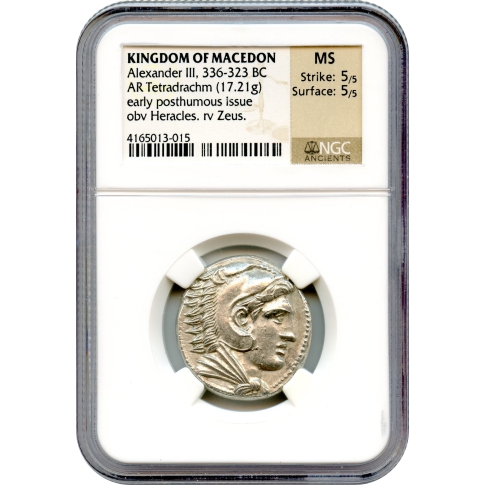Ancient Greece - 336-323 BCE Kingdom of Macedon Alexander III AR Tetradrachm NGC MS
The tetradrachms of Alexander III, commonly known as Alexander the Great, are among the most famous coins in ancient numismatics. Here's what we know about these coins, particularly those struck between 336 and 323 BCE:
Design and Iconography
Obverse: The obverse features a depiction of Heracles, the Greek demigod known for his prodigious strength, courage, and numerous far-ranging adventures. Heracles is shown in the style of a portrait of Alexander himself, wearing the lion scalp of the Nemean Lion, which was one of Heracles' most famous conquests. This representation not only symbolizes strength and divine lineage but also subtly merges Alexander's image with that of Heracles, suggesting a heroic and divine status for Alexander.
Reverse: The reverse side portrays Zeus, the king of the gods in Greek mythology, seated on a throne. He holds an eagle in one hand and a scepter in the other, symbols of his authority and power. The depiction of Zeus was a nod to Alexander's claim of divine parentage, as his mother, Olympias, claimed that Zeus was his true father.
Historical Context
Minting Period:
These coins were minted during Alexander's reign and continued to be produced posthumously, which means they were struck after his death in 323 BCE but still bore his image and symbols. This practice was common as a way to maintain continuity and legitimacy in the regions he conquered.
Purpose:
These tetradrachms served as a currency for Alexander's vast empire, stretching from Greece through Persia to as far as India. They were used to pay his armies, fund his campaigns, and facilitate trade across his empire. The uniformity of these coins also helped in establishing economic stability and recognition across different regions.
Numismatic Features
Weight and Metal:
These tetradrachms were made of silver, with a standard weight of around 17.2 grams, though this could vary slightly based on mint and era. The purity of the silver was also generally high, which contributed to their wide acceptance.
Mint Marks:
Various mints across Alexander's empire produced these coins, and while many do not have explicit mint marks, numismatists can often identify the mint by subtle differences in style, monograms, or symbols.
Artistic Quality:
The artistry on these coins was of high quality, reflecting the cultural and artistic peak of the Hellenistic period. The detailed engraving and the idealized portrayal of Heracles and Zeus were not just functional but also served as propaganda tools, showcasing Greek culture and Alexander's divine right to rule.
Legacy
Posthumous Issues:
After Alexander's death, his empire was divided among his generals (the Diadochi), who continued to mint these coins to legitimize their rule by association with Alexander's legacy. This practice led to a wide variety of styles and minor changes over time.
Influence:
The design and concept of these coins influenced coinage in the Hellenistic world and beyond, with many rulers adopting similar motifs to claim legitimacy or divine favor.
Collectibility:
Today, these tetradrachms are highly sought after by collectors due to their historical significance, artistic value, and the legendary figure they represent. They provide a tangible link to one of history's most influential figures and periods.
These coins not only served as economic tools but also as powerful symbols of Alexander's divine authority and the cultural unity he sought to impose across his empire. --Grok
| Grading Service | NONE |
|---|---|
| Year of Issue | NONE |
| Grade | NONE |
| Ancient Year Range | 4th C. BC |
| Denom Type | N/A |
| Numeric Denomination | AR Tetradrachm |
| Mint Location | NONE |
| Designation | NONE |
| Circ/UnCirc | Not Specified |
| Strike Type | N/A |
| Holder Variety | Strike 5/5; Surface 5/5 |
| Grade Add On | NONE |
| Holder Type | N/A |



